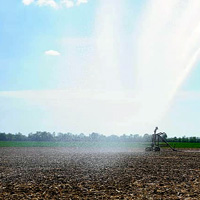Treated wastewater outperformed freshwater for barley irrigation in arid lands

Accepted: 25 May 2020
HTML: 202
All claims expressed in this article are solely those of the authors and do not necessarily represent those of their affiliated organizations, or those of the publisher, the editors and the reviewers. Any product that may be evaluated in this article or claim that may be made by its manufacturer is not guaranteed or endorsed by the publisher.
The high demand of barley for animal feed and the scarcity of fresh water increase the need for the reuse of treated wastewater as an alternative source for irrigation. Therefore, two-field experiments were conducted to study physiological processes, plant growth, grain yield and yield components of four-barley cultivars grown under four-irrigation treatments using treated wastewater or fresh water. Plants of four-barley cultivars (ACSAD176, Rum, Athroh, Yarmouk) were exposed to four-irrigation treatments: i) Full-irrigation using treated wastewater (FWW); ii) Supplementary-irrigation using treated wastewater (SWW); iii) Supplementary-irrigation using fresh water (SFW); 4) Non-irrigation treatment (Rainfed). Full- or supplementary-irrigation using treated wastewater reduced stomatal resistance and increased plant photosynthetic rate, plant height, grain yield and yield components as estimated by grain number plant–1 and 1000-grain weight compared with rainfed conditions. Plants grown under supplementary-irrigation using treated wastewater produced higher grain yield than those grown under supplementary-irrigation using fresh water. Rum cultivar had the highest grain yield among cultivars grown under irrigation. Under rainfed conditions, Rum and ACSAD176 had the highest grain yield. In conclusion, supplementary-irrigation using treated wastewater improved grain yield of barley and can be a better choice to conserve water and reduce the risk of plant lodging at the end of the growing season. Irrigation of barley using treated wastewater did not change heavy metal (Zn, Cd, and Pb) concentrations in soil or harvested grains.
Highlights
- Full- or supplementary-irrigation using treated wastewater increased photosynthetic rate and grain yield of barley compared with rainfed.
- Supplementary-irrigation using treated wastewater produced higher grain yield than supplementary-irrigation using fresh water.
- Rum cultivar had the highest grain yield among cultivars grown under irrigation.
- Under rainfed conditions, Rum and ACSAD176 cultivars had the highest grain yield.
- Irrigation using treated wastewater did not change the concentration of heavy metals in soil and barley grains.
How to Cite
PAGEPress has chosen to apply the Creative Commons Attribution NonCommercial 4.0 International License (CC BY-NC 4.0) to all manuscripts to be published.

 https://doi.org/10.4081/ija.2020.1610
https://doi.org/10.4081/ija.2020.1610



